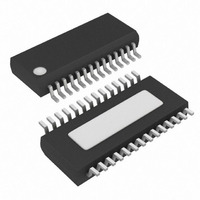MAX9526AEI+ Maxim Integrated Products, MAX9526AEI+ Datasheet - Page 13

MAX9526AEI+
Manufacturer Part Number
MAX9526AEI+
Description
IC VID DECODER NTSC/PAL 28-QSOP
Manufacturer
Maxim Integrated Products
Type
Video Decoderr
Datasheet
1.MAX9526AEI.pdf
(38 pages)
Specifications of MAX9526AEI+
Applications
Automotive Systems, Players, TV
Voltage - Supply, Analog
1.8V
Voltage - Supply, Digital
1.8V
Mounting Type
Surface Mount
Package / Case
28-QSOP
Operating Supply Voltage
1.8 V
Maximum Operating Temperature
+ 125 C
Bandwidth
180 Hz to 2 KHz
Maximum Power Dissipation
1009 mW
Minimum Operating Temperature
- 40 C
Mounting Style
SMD/SMT
Snr
58.8 dB
Lead Free Status / RoHS Status
Lead free / RoHS Compliant
standards automatically. See the Standard Select,
Shutdown, and Control Register section for manual pro-
gramming.
The sync processor block also detects analog copy
protection. Extracted copy protection information is
available in Status register 0x01.
In addition to the analog AGC that optimizes the ADC
full-scale range, a digital AGC is used to more accu-
rately set the video amplitude. The Composite AGC
uses the amplitude of the sync signal to set the gain.
The MAX9526 uses a 5-line adaptive comb filter to sep-
arate luminance and chrominance components from a
single composite channel. The adaptation algorithm
does not require configuration. The adaptive comb filter
adjusts based on the relationship and content of video
data between neighboring lines. The filter automatically
adapts the comb filter structure between a 5-line filter
and a notch filter.
After luminance (Y) and chrominance (C) components
are separated, the Y component passes through a
delay line to compensate for the C component delay
through the demodulator. The chrominance signal path
contains an AGC before the signal demodulator. The
chrominance AGC uses the color burst amplitude to set
the gain. The chrominance is demodulated using a
subcarrier signal locked to the burst. The demodulated
chrominance signals, Cb and Cr, are lowpass filtered to
eliminate unwanted products of demodulation.
Figure 3. Digital Composite Decoding Functional Diagram
FRONT-END
NONSTD
ANALOG
FROM
VIDEO
Composite Automatic Gain Control (AGC)
10
PROTECTION DETECT
______________________________________________________________________________________
SYNC EXTRACTION
AND ANALOG COPY
SYNC PROCESSOR
Chrominance Signal Demodulator
CORRECTION
SYNC-LEVEL
AND
NTSC/PAL
NONSTD VIDEO
HORZ, VERT, FRAME
Adaptive Comb Filter
COMPOSITE
AGC
Low-Power, High-Performance
DELAYS
LINE
NTSC/PAL Video Decoder
ADAPTIVE
FILTER
COMB
Figure 4 shows the output formatting section of the
MAX9526.
The MAX9526 provides contrast, brightness, hue, and
saturation manual control in registers 0x05 to 0x08.
The MAX9526 provides time base correction (TBC) to
allow the decoder to properly process unstable and
nonstandard video from sources such as a VCR. The
time base correction minimizes the effect of sampling
jitter to ensure that there are a correct number of pixels
per active line.
The MAX9526 automatically outputs a black screen
when there is no video at the inputs. The test pattern
can also be configured to provide a blue screen, 75%
color bars, or 100% color bars through register 0x0C.
The MAX9526 multiplexes the Y, Cr, and Cb signals
with an embedded timing reference signal conforming
to the ITU-R BT.656 standard.
SAV and EAV sequences are inserted into the data
stream to indicate the active video time in ITU-R BT.656
format. The output timing insertion is illustrated in
Figure 5. The SAV and EAV sequences are shown in
Table 2.
The output setup and hold diagram is shown in Figure 6.
CHROMA
AGC
Image Enhancement and Color Correction
Timing Reference Signal Insertion
DEMODULATOR
CHROMINANCE
Y-DELAY
and ITU-R BT.656 Encoding
Output Formatting
Time Base Correction
Test Pattern Insertion
Y/Cb/Cr
FILTERS
LPF
LPF
Output Timing
Y
Cb
Cr
TIMING
INFO
13











